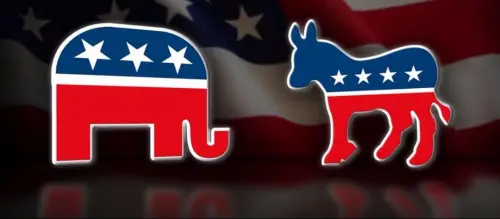Political parties and interest groups are organizations that play important roles in a modern, democratic government. While sharing a lot in common, these groups are not the same as each possesses distinct characteristics and purposes. This article explains their major differences.
Summary Table
| Political Parties | Interest Groups |
| Participate in elections | Do not participate in elections |
| Have financial backing | Little or no financial resources |
| Members follow only one party | Members will usually follow anyone who believes in their cause. |
Descriptions

Political parties are distinct groups of people who have joined together with the main purpose of holding power and influence in government through winning in elections. This is achieved by helping a political candidate win an election by conducting various campaigns such as advertising and fundraisers. These political groups usually agree on some proposed agendas and programs that push the interests of the many or of their supporters.
Political parties usually have a fundamental ideology, although it is not rare for groups to not have some basic ideological belief systems. Others evolved and had grown different from the original ideology the party supported when it was first founded. In most democratic states, political parties are chosen via an electoral process. In the US, a two-party system is observed, although some significant political parties and independent candidates also participate in the process. The Democratic Party and the Republican Party are the two major parties.

Interest groups are advocacy groups, campaign groups, lobby groups, or special interest groups that make use of various methods to affect public opinion and policy making of a state. They are often considered important in the development of social and political systems. While the size, agenda, and influence of these groups widely vary, some have far-reaching and long-term social objectives. Others tackle a specific issue and are established to specifically address an immediate cause.
Interest groups act on common political, moral, religious, health, and even commercial points of view. These groups make use of various methods to achieve their goals such as media campaigns. lobbying, research, polls, publicity stunts, and policy discussion. Interest groups are sometimes supported by big corporations or political agendas that allow them to wield a high level of influence in policy making. However, there are interest groups that have little or no such backing.
It is common to see interests groups evolve into social movements and political institutions. A few influential interest groups have been accused of controlling the democratic system for economic gains. Others are guilty of bribery, corruption, and fraud. Small interest groups with little or no financial resources sometimes use civil disobedience and direct action to air their views. Experts are starting to discover how interest groups are using social media to promote public engagement and collective action.
Political Parties vs Interest Groups
So what’s the difference between political groups and interest groups? The main difference that separates them stems from why they exist in the first place. Political parties support politicians in elections to win votes so that the party is represented in the governing body of their country or state. Interest groups, on the other hand, do not participate in elections. They do not seek to get the people’s votes.
Political parties are supported by money and are a well-oiled organization with functioning parts and defined responsibilities. Interest groups normally do not enjoy systematic machinery-like workings, nor do they get financial backing. In terms of the common good, political parties are often in agreement on many issues compared to interest groups who usually operate on a basic ideology to achieve an ultimate goal.
Video
Here’s a YouTube video that talks about political parties and interest groups.





